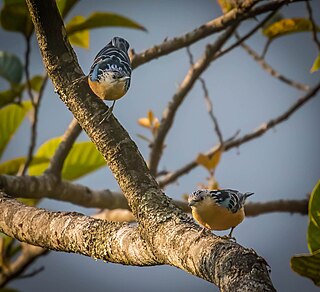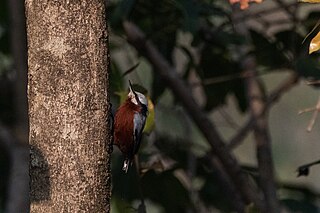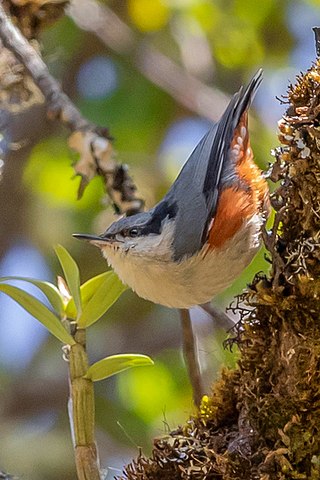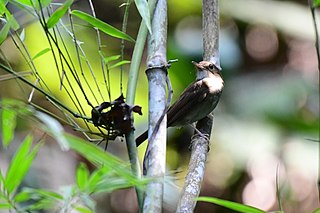
The nuthatches constitute a genus, Sitta, of small passerine birds belonging to the family Sittidae. Characterised by large heads, short tails, and powerful bills and feet, nuthatches advertise their territory using loud, simple songs. Most species exhibit grey or bluish upperparts and a black eye stripe.

The beautiful nuthatch is a bird species in the family Sittidae, collectively known as nuthatches. It is a large nuthatch, measuring 16.5 cm (6.5 in) in length, that is not sexually dimorphic. Its coloration and markings are dramatic, the upper parts being black and azure, streaked with white and pale blue on the head and lined with the same colors on the wing feathers. The are orange, and the and are ochre. An irregular, dark highlights its eye. S. formosa's ecology is not fully described, but it is known to feed on small insects and larvae found on the trunks and epiphyte-covered branches of trees in its range. Reproduction takes place from April to May; the nest is placed in the hole of an oak, rhododendron, or other large tree. The nest is made of plant material and fur in which the bird typically lays four to six eggs.

The velvet-fronted nuthatch is a small passerine bird in the nuthatch family Sittidae found in southern Asia from Nepal, India, Sri Lanka and Bangladesh east to south China and Indonesia. Like other nuthatches, it feeds on insects in the bark of trees, foraging on the trunks and branches and their strongly clawed toes allow them to climb down tree trunks or move on the undersides of horizontal branches. They are found in forests with good tree cover and are often found along with other species in mixed-species foraging flocks. Adult males can be told apart by the black stripe that runs behind and above the eyes. They have a rapid chipping call note. They breed in tree cavities and holes, often created by woodpeckers or barbets.

The Chin Hills-Arakan Yoma montane forests is a tropical and subtropical moist broadleaf forest ecoregion in western Myanmar (Burma). Surrounded at lower elevations by moist tropical forests, this ecoregion is home a diverse range of subtropical and temperate species, including many species characteristic of the Himalayas, as well as many endemic species.

The green cochoa is a bird species that was variously placed with the thrushes of family Turdidae or the related Muscicapidae. It is considered closer to the former.

The rufous-chinned laughingthrush is a bird species in the family Leiothrichidae. It ranges across the northern parts of the Indian subcontinent and some parts of Southeast Asia.

The Guianan streaked antwren is a species of bird in the family Thamnophilidae. It is found in tropical South America where its natural habitats are subtropical or tropical moist lowland forests, tropical swamps, and heavily degraded former forest. It is a small, black and white streaked bird, the female being distinguished by its rufous-cinnamon head and buff underparts.

The blue nuthatch is a bird species in the nuthatch family Sittidae. It is a medium-sized nuthatch, measuring 13.5 cm (5.3 in) in length. The species, which shows slight sexual dimorphism, has dramatic coloration unlike any other member of its genus. Its head is black or blackish-blue dark blue upperparts close to purple with azure feathers. The wings are edged with black. The throat and chest are white or a washed buff color, contrasting with the upperparts and the belly of a very dark blue; the covert feathers are generally clear, blue-gray or purplish.

The Indian nuthatch is a species of bird in the family Sittidae. It is found in Bangladesh, India and Nepal.

The white-tailed nuthatch is a species of bird in the family Sittidae. It ranges across the northern and northeastern parts of the Indian Subcontinent, existing mainly in the low-to-middle Himalayas, as well as associated mountain ranges. It is found in Bhutan, India, Laos, Myanmar, Nepal, Tibet and Thailand.

The chestnut-vented nuthatch is a species of bird in the nuthatch family Sittidae. It is a medium-sized nuthatch, measuring 12.5–14 cm (4.9–5.5 in) in length. The upperparts are a solid gray blue, with a markedly black loral stripe. The underparts are uniform gray to buff from the throat to belly, with brick red on the flanks. The undertail is white with a rufous border. The chestnut-vented nuthatch utters different kinds of calls, which can sometimes sound like a troglodyte alarm, and its song is a monotonous, stereotypical crackle, typically chichichichi. Its ecology is poorly known, but it probably feeds on small arthropods and seeds, and the breeding season begins between March and May. The nest is typically located in a hole in the trunk of a tree, and the clutch has two to five eggs.

The sulphur-billed nuthatch is a species of bird in the family Sittidae. It is endemic to the Philippines. Its natural habitats are subtropical or tropical moist lowland forest and subtropical or tropical moist montane forest. It is commonly found in mixed flocks along with Blue-headed fantails, sunbirds, flowerpeckers and other small forest birds.

The yellow-billed nuthatch is a species of bird in the family Sittidae. It is found in Hainan, Laos, and Vietnam.

The laced woodpecker is a species of bird in the family Picidae.

The Andaman shama is a species of bird in the family Muscicapidae. It is endemic to the Andaman Islands. It was previously considered a subspecies of the white-rumped shama. Its natural habitats are subtropical or tropical dry forests and subtropical or tropical moist lowland forests.

The Andaman flowerpecker is a species of bird in the family Dicaeidae. It is endemic to the Andaman Islands.

The plain flowerpecker is a bird in the family Dicaeidae. The species was described and given its binomial name by Robert Swinhoe in 1870. It is found in the central Himalayas, through western Indonesia to Taiwan.

The chestnut-bellied nuthatch belongs to the family Sittidae.

The Nicobar jungle flycatcher is a species of bird in the Old World flycatcher family Muscicapidae. It is endemic to the Nicobar Islands, where its natural habitats are subtropical or tropical moist lowland forests and subtropical or tropical mangrove forests. It was at one time considered a subspecies of the brown-chested jungle flycatcher.

Przevalski's nuthatch, originally given the nomen nudumSitta eckloni, is a bird species in the family Sittidae, collectively known as nuthatches. Long regarded as a subspecies of the white-cheeked nuthatch, it nevertheless differs significantly in morphology and vocalizations. Both S. przewalskii and S. leucopsis have been regarded as closely related to the North American white-breasted nuthatch. It is a medium-sized nuthatch, measuring about 13 cm (5 in) in length. Its upper body is a dark gray-blue or slate color, becoming dark blue-black at the crown. The cheeks and throat are a white buff-orange, turning to a rich cinnamon on the underparts that intensifies in color on the sides of the breast. Vocalizations consist of alternating series of ascending whistles and short notes.




















